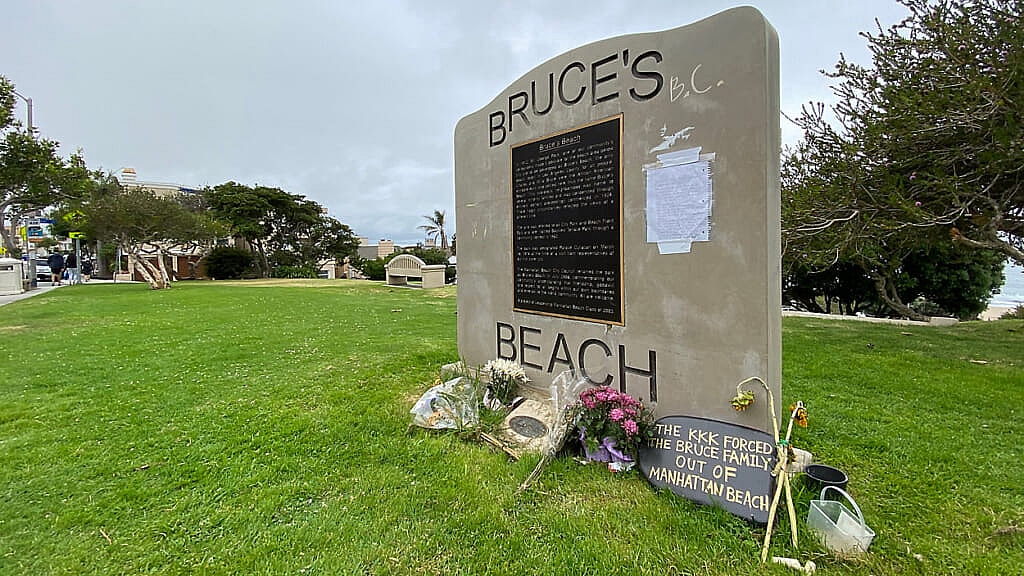With racial justice on our minds and in the public conscience, it is time to decide what that justice will look like, and what it should look like. For Black and Indigenous people who have experienced historic loss, reparations and restorative justice must be a part of the solution. And this includes land; land that white supremacy stole from us by means of duplicity, violence, eminent domain and the machinations of the legal system.
In a landmark move, California Gov. Gavin Newsom signed a bill restoring prime beachfront land to the heirs of a Black family driven from the property nearly a century ago. A Black couple named Willa and Charles Bruce had bought the land in Manhattan Beach in Southern California in 1912, a thriving Black resort called Bruce’s Beach. After an attempted arson from the Klan and harassment from white neighbors, the Manhattan Beach city council seized the land by eminent domain and claimed the land would be used for a public park.

This recent return of California Beach resort land to a Black family is just one example of efforts to reclaim Black, Brown and Indigenous land, provide repair for the theft and make people whole.
“Closing the wealth gap is imperative, but before we look forward, let’s look back. Look back at what was taken. Black communities across America were thriving until land was stolen,” said Ashanti Martin, co-founder of Where Is My Land (WIML). WIML, a national organization that arose from its campaign in Bruce’s Beach, seeks to reclaim stolen Black folks’ land and get them reparations for lost wealth and businesses. Another organization, Decolonizing Wealth Project, is also educating the public on the need for reparations, with a #Case4Reparations initiative aimed at sparking discussions and campaigns around wealth redistribution for Black and Indigenous people in America.
“We are not asking for a handout or new social programs. We want the land back, and we want restitution to be paid,” Martin added.
WIML is also seeking justice and restitution for Black developer Winston Willis. The city of Cleveland seized and bulldozed Willis’ land to make way for an expansion of Cleveland Clinic, a top-ranking hospital in a once thriving Black community that is predominantly impoverished.
“We know what Cleveland Clinic did to Winston Willis. They seized and destroyed not only Winston’s property, but the heart of Black life in Cleveland during the 1960s and 1970s,” said Kavon Ward, WIML co-founder and founder of Justice for Bruce’s Beach. “I said it before and I will say it again: How can we pull ourselves up by our bootstraps when the boots and the socks are stolen right off our feet?”

The common whitesplainer’s narrative of racial inequality and the racial wealth gap is that Black people lag behind white people because of laziness and personal flaws. But in reality, we must point the finger at systemic and institutional racism, of policies such as redlining and eminent domain, racially discriminatory policies of the USDA and other government agencies, and loan programs that kept us out of the game.
And in areas such as the Gullah-Geechee Sea Islands of the Carolinas, Georgia and Florida, unscrupulous developers have occupied land by exploiting heirs’ property — the traditional means by which many Black families have passed land to the next generation without wills or other written legal documents. Meanwhile, climate change further threatens the land and lives of these Black communities who are already living a precarious existence.
And in a country where land builds wealth, the bigger picture is Black farmers have lost 12 million to 14 million acres of land over the past century. You did not misread that.
While we are paying more attention to the 1921 destruction of the Greenwood section of Tulsa by the white mob — as we should — “Black Wall Street” is only the tip of the iceberg. Land theft — of Native Americans, of Black people, of people of color — is what made America.
Pay us what you owe us. Give back the land.

Follow David A. Love on Twitter at @davidalove
Have you subscribed to theGrio’s “Dear Culture” podcast? Download our newest episodes now!
TheGrio is now on Apple TV, Amazon Fire and Roku. Download theGrio.com today!


